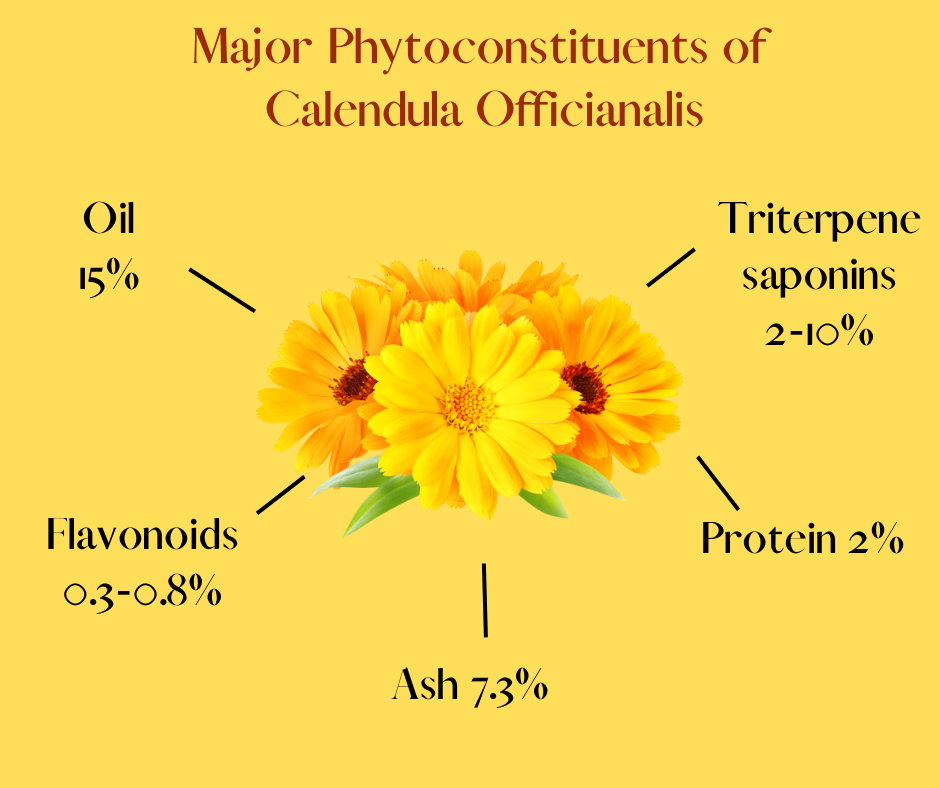
“Transform Your Skin with Calendula: A Herb for Health and Beauty”
Plants have been a rich source of effective and safe treatments for centuries. Herbal medicines have been the immediate source of primary healthcare in many nations.
As per WHO, 88% of all countries are estimated to use traditional medicine, such as herbal medicines; traditional medicine has been a vital resource for health for centuries in communities worldwide.
Over 40% of pharmaceutical formulations are based on natural products and landmark drugs, including aspirin and artemisinin, originated from traditional medicine!
Herbal medicines are honored for their low cost, easy availability, no side effects, and time-tested benefits.
One flowering herb stands tall among many such celebrated herbs, called “Calendula.”

What is Calendula?
Calendula, Medically called Calendula Officinalis & commonly known as Pot Marigold, is a member of the daisy family called Asteraceae.
Calendula is a beautiful herbaceous herb with narrow bright yellow or vibrant orange petals, and it can grow up to one or two feet tall.
Calendula is native to southwestern Asia, western Europe, and the Mediterranean, but they’ve been cultivated worldwide thanks to its incredible healing properties.
Calendula makes a perfect companion plant in any vegetable or pollinator-friendly garden!
This flower lures bees and butterflies and is known to repel pest insects, and it’s roots may help increase the activity of healthy microbes and fungi in the soil.
Calendula Officinalis is one of my favorite herbs to treat skin issues, as I have been using it for many yrs, and I have observed the extraordinary healing powers this wonderful herb has.
Preparations of C. Officinalis can be used as a dietary supplement, extract, infusions, tinctures, oils, and ointments.
Topically it is used as a wound-healing remedy for inflammations of the Skin, mucous membranes, poorly healing wounds, bruises, boils, rashes, etc.
Calendula has been used for culinary & medicinal purposes for many centuries.

Fresh or dried vibrant leaves of Calendula can be sprinkled on top of the salad, frittata, soup, salsa, scrambled eggs, decorated cakes, and even Calendula tea made with whole flowers.

Calendula Usage in Traditional & Natural Medicine
Calendula extract, which comes from the leaves, petals, and seeds of the flower, has been traditionally used in Homeopathic, Ayurvedic, Unani and Chinese Medicine.
The available scripts reveal that amongst 12-20 species of Calendula, only three species, i.e., C. officinalis, C. Avensis and C. suffruticosa, have been evaluated for their pharmacological activities.
Among the various genus species, Calendula Officinalis is the only one extensively used clinically worldwide!
C.Officinalis is documented in German Commission E, European Scientific Co-operative, British Herbal Pharmacopoeia, and World Health Organization monographs for wound healing and anti-inflammatory actions.
Pharmacological studies demonstrate that Calendula officinalis exhibits antibacterial, antiviral, anti-inflammatory, antitumor, and antioxidant properties.
Calendula has been demonstrated to help with the following.
- Lessen inflammation (anti-inflammatory)
- Prevent blood from clotting too much (anti-thrombogenic)
- Managing Diabetes (the promising effects of Calendula officinalis in the treatment of diabetes, particularly its leaf extract on reducing blood glucose, have been reported)
- Help fight cancer (Extracts possess chemopreventive, antitumor, and antimetastatic activity in vivo).
- Neuroprotective properties (Protects brain & CNS against oxidative stress)
- Helps with menstrual irregularities
- Used for treating duodenal & peptic ulcers by supporting healing gastric and intestinal inflammation from infection or irritation.
For medicinal preparations, Whole dried flowers should be used as therapeutic oils, which are found mainly in the green base of the flower head. The dried flower heads have been used for their antipyretic, antitumor, and cicatrizing effects.
Therapeutic Actions of Calendula Officinalis
- Antiepileptic
- Antimicrobial
- Antispasmodic
- Hypolipidemic
- Antifungal
- Antimutagenic
- Antiviral
- Immunostimulant
- Antipyretic
- Astringent
- Chloretic
- Hemostatic
Medical Conditions traditionally treated with Calendula Officinalis
- Acne
- Conjunctivitis
- Dysmenorrhoea
- Gingivitis
- Mouth Ulcers
- Phlebitis
- Skin Infections
- Tonsillitis
- Pharyngitis
- Burns
- Cutaneous Lesions
- Eczema
- Hemorrhoids
- Peptic ulcers
- Psoriasis
- Sore throat
- Varicose Veins
- Candidiasis
- Diarrhea
- Epistaxis
- Lymphadenitis
- Seizures
- Splenomegaly
- Wounds

Major phytoconstituents of Calendula Officianalis
(phytoconstituents- chemical compounds or bioactive compounds of a plant)
Oil 15%
Triterpene saponins: 2-10%
Carotenoids: up to 4.7%; predominately lutein and zeaxanthine.
Flavonoids: 0.3-0.8%
Protein 2%
Ash 7.3%
Calendula tea is used for eyewashes, gargles, diaper rashes, and other inflammatory conditions of the Skin and mucous membranes.
In Homeopathy, Calendula can be used as a Mother Tincture (herbal extract) or in potencies depending on the indication of use.

Learn about the incredible benefits of Calendula Officinalis for your SKIN
Calendula officinalis flowers have long been topically employed in folk therapy as remedies for diverse burns, including sunburns and skin wounds.
Topical gels made from Calendula may help with the collagen in the Skin, promote new tissue growth in wound healing, and help decrease skin inflammation.
Research has also shown that calendula ointment increased skin healing time in women with c-sections.
Calendula is considered to be a safe topical therapy for treating and preventing radiation-induced skin toxicity.
The study “Calendula Extract: Effects On Mechanical Parameters Of Human Skin,” published in 2011, demonstrates Calendula increases the Skin’s hydration, induces skin tightness, and even delays the aging process by preventing damage to the Skin.

Calendula Officinalis has incredible skin healing benefits; it helps with
- Rashes
- Stings
- Wounds
- Burns
- Sunburns
- Abrasions
- Swellings
- Eczema
- Acne
- Insect bites
- Scratches
- Bruises
- Chickenpox (relieving the itch & enhances healing)
- Cold sores
- Cracked/sore nipples from nursing
- Bacterial vaginosis (douche or ointment)
- Yeast infections (douche or ointment)
- Cervical dysplasia (douche)
- Postpartum perineal tears (sitz bath & ointment)
Safety and contraindications
There are no reported contraindications with using Calendula officinalis nor known interactions between Calendula and other medications when administered topically.
However, it is recommended that individuals with a known sensitivity to other species in the Compositae family, such as Ragweed, Chrysanthemum, and Daisy, avoid using Calendula due to the likely risk of allergic reaction.
Yet, there is only a small data to back this claim.
It has been a privilege explaining the incredible health benefits of Calendula Officinalis; I hope you liked this blog.
Remember to share it with your friends & family.
Don’t forget to subscribe!
Disclaimer
The information in this blog is presented to educate readers on overall skin health; below are the references used.
The information presented in this blog is not intended as medical advice. It should not be used as medical advice, should not be considered complete, or take the place of a consultation with a physician or competent healthcare professional for medical diagnosis and/or treatment; or serve as an endorsement for any medical practice, treatment, physician, pharmaceutical product, or medical device.
REFERENCES
https://www.who.int/initiatives/who-global-centre-for-traditional-medicine
https://www.ncbi.nlm.nih.gov/pmc/articles/PMC3841996/
Miliauskas G, Venskutonis PR, Van Beek TA. Screening of radical scavenging activity of some medicinal and aromatic plant extracts. Food Chem. 2004;85:231–7. [Google Scholar]
https://www.ncbi.nlm.nih.gov/pmc/articles/PMC3841996/#ref19
http://www.journalofnaturalproducts.com/Volume1/04__Review_vol_01-2008_s.pdf?origin=publication_detail&ev=pub_ext_prw_xdl
https://pubmed.ncbi.nlm.nih.gov/27974009/
https://pubmed.ncbi.nlm.nih.gov/21928714/
https://pubmed.ncbi.nlm.nih.gov/31145533/
https://pubmed.ncbi.nlm.nih.gov/20026397/
https://www.ncbi.nlm.nih.gov/pmc/articles/PMC4665477/
https://pubmed.ncbi.nlm.nih.gov/11456093/
https://www.hmpgloballearningnetwork.com/site/wounds/article/9064
https://www.ncbi.nlm.nih.gov/pmc/articles/PMC7999767/
https://www.ema.europa.eu/en/documents/herbal-report/final-assessment-report-calendula-officinalis-l-flos-revision-1_en.pdf
https://www.ncbi.nlm.nih.gov/pmc/articles/PMC3931201/
https://brieflands.com/articles/jjnpp-55456.html
https://www.ncbi.nlm.nih.gov/pmc/articles/PMC6247547/
https://www.sciencedirect.com/science/article/pii/S0378874109007740?via%3Dihub
https://www.ptfarm.pl/pub/File/Acta_Poloniae/2011/5/693.pdf
